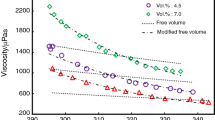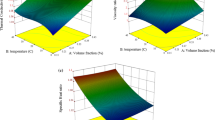Abstract
Nowadays, variant strategies are proposed and evaluated to find the best scenario for upgrading the high-accurate QSAR/QSPR modeling, particularly on nano-scale. One of the most interesting samples is nanofluids because of high potential in heat transfer applications. In the case of nano-QSPR, some optimum empirical conditions and characteristic features (e.g., size of nanoparticles and temperature) play impressive roles in nanofluids’ properties. Quasi-simplified molecular input-line entry-system (quasi-SMILES) is nominated as valuable linear notation to meet the demands for representation of nanofluids, either chemical structure or defined conditions. The outcomes of nano-QSPR modeling of nanofluids by quasi-SMILES not only make possible the incorporation of molecular structure with experimental conditions in modeling process but also reveal the influence of some molecular features on studied thermophysical properties. Herein, recent studies on the development of predictive models of nanofluids using quasi-SMILES, which is a new trend to estimate the properties of nanofluids, were discussed comprehensively. It is remarkable to point out that the statistical evaluation of proposed models confirmed the predictability power, reliability, and credit of developed models in all reported cases. It is rational that scholars are working on improving QSAR/QSPR modeling; employing quasi-SMILES is an open opportunity to overcome the limitations of conventional molecular representation.
Access this chapter
Tax calculation will be finalised at checkout
Purchases are for personal use only
Similar content being viewed by others
Abbreviations
- ANN:
-
Artificial neural network
- ANFIS:
-
Adaptive neuro-fuzzy inference system
- F k :
-
Extracted feature of quasi-SMILES
- AAD:
-
Average absolute deviation
- CORAL:
-
Correlation and logic
- CW(Fk):
-
Correlation weight of Fk
- CCC:
-
Concordance correlation coefficient
- C p :
-
Isobaric heat capacity
- CII :
-
Correlation intensity index
- DTR:
-
Decision tree regression
- DCW:
-
Optimal descriptor based on quasi-SMILES
- EG:
-
Ethylene glycol
- IIC :
-
Index of ideality of correlation
- GBR:
-
Gradient boosting regression
- MAE:
-
Mean absolute error
- MLP :
-
Multi-layer perceptron
- Q 2 :
-
Leave-one-out cross-validated correlation coefficient
- QSAR:
-
Quantitative structure–activity relationship
- QSPR:
-
Quantitative structure–property relationship
- Quasi-SMILES:
-
Quasi-simplified molecular input-line entry-system
- R 2 :
-
Correlation coefficient
- RBF:
-
Radial basis function
- RFR:
-
Random forest regression
- RMSE:
-
Root mean square error
- LDM:
-
Liquid drop model
- LSSVM:
-
Least square support vector machine
- SVR:
-
Support vector regression
- TC:
-
Thermal conductivity
- TF:
-
Target function
- ρ :
-
Density
- φ :
-
Volume fraction of nanoparticle (%)
- bf:
-
Base fluid
- nf:
-
Nanofluid
- p:
-
Nanoparticle
- v:
-
Volume fraction
- Ag:
-
Silver
- Al2O3:
-
Aluminium oxide
- AlN:
-
Aluminum nitride
- Au:
-
Gold
- Bi2O3:
-
Bismuth (III) oxide
- CeO2:
-
Cerium (IV) oxide
- Co3O4:
-
Cobalt (II,III) oxide
- Cr2O3:
-
Chromium (III) oxide
- Cu:
-
Copper
- CuO:
-
Copper oxide
- Dy2O3:
-
Dysprosium (III) oxide
- Fe:
-
Iron
- Fe2O3:
-
Iron (III) oxide
- Fe3O4:
-
Iron (II,III) oxide
- Gd2O3:
-
Gadolinium (III) oxide
- HfO2:
-
Hafnium (IV) oxide
- In2O3:
-
Indium (III) oxide
- La2O3:
-
Lanthanum oxide
- MgO:
-
Magnesium oxide
- Mn2O3:
-
Manganese (III) oxide
- Mn3O4:
-
Manganese (II,III) oxide
- Ni2O3:
-
Nickel (III) oxide
- NiO:
-
Nickel (II) oxide
- Sb2O3:
-
Antimony oxide
- Si3N4:
-
Silicon nitride
- SiC:
-
Silicon carbide
- SiO2:
-
Silicon dioxide
- SnO2:
-
Tin (IV) oxide
- TiN:
-
Titanium nitride
- TiO2:
-
Titanium dioxide
- WO3:
-
Tungsten (VI) oxide
- Y2O3:
-
Yttrium (III) oxide
- Yb2O3:
-
Ytterbium (III) oxide
- ZnO:
-
Zinc oxide
- ZrO2:
-
Zirconium oxide
References
Hamze S, Cabaleiro D, Estellé P (2021) J Mol Liq 325:115207. https://doi.org/10.1016/j.molliq.2020.115207
Ghalandari M, Maleki A, Haghighi A, Shadloo MS, Nazari MA, Tlili I (2020) J Mol Liq 313:113476. https://doi.org/10.1016/j.molliq.2020.113476
Jafari K, Fatemi MH, Estellé P (2021) J Mol Liq 321:114752. https://doi.org/10.1016/j.molliq.2020.114752
Asadi A, Aberoumand S, Moradikazerouni A, Farzad P, Gaweł Ż, Patrice E, Omid M, Somchai W, Nguyen Hoang M, Arabkoohsar A (2019) Powder Technol 352:209–226. https://doi.org/10.1016/j.powtec.2019.04.054
Asadi A, Pourfattah F, Miklós Szilágyi I, Afrand M (2019) Ultrason Sonochem 58:104701. https://doi.org/10.1016/j.ultsonch.2019.104701
Hajatzadeh Pordanjani A, Aghakhani S, Afrand M, Mahmoudi B, Mahian O, Wongwises S (2019) Energy Convers Manag 198:111886. https://doi.org/10.1016/j.enconman.2019.111886
Rashidi S, Mahian O, Languri EM (2018) J Therm Anal Calorim 131:2027–2039. https://doi.org/10.1007/s10973-017-6773-7
Mahian O, Kolsi L, Amani M, Estellé P, Ahmadi G, Kleinstreuer C, Marshall JS, Siavashi M, Taylor RA, Niazmand H, Wongwises S (2019) Phys Rep 790:1–48. https://doi.org/10.1016/j.physrep.2018.11.004
Maleki A, Haghighi A, Mahariq I (2021) J Mol Liq 322:114843. https://doi.org/10.1016/j.molliq.2020.114843
Sharma P, Ramesh K, Parameshwaran R, Deshmukh SS (2022) Case Stud Therm Eng 30:101658. https://doi.org/10.1016/j.csite.2021.101658
Cui W, Cao Z, Li X, Lu L, Ma T, Wang Q (2021) Powder Technol 398:117078. https://doi.org/10.1016/j.powtec.2021.117078
Novoselska N, Rasulev B, Gajewicz A, Kuz’min V, Puzyn T, Leszczynski J (2014) Nanoscale 6:13986–13993. https://doi.org/10.1039/C4NR03487B
Jafari K, Fatemi MH (2020) J Therm Anal Calorim 142(3):1335–1344. https://doi.org/10.1007/s10973-019-09215-3
Jafari K, Fatemi MH (2020) Adv Powder Technol 31:3018–3027. https://doi.org/10.1016/j.apt.2020.05.023
Toropova AP, Toropov AA (2019) J Mol Struct 1182:141–149. https://doi.org/10.1016/j.molstruc.2019.01.040
Toropova AP, Toropov AA, Rallo R, Leszczynska D, Leszczynski J (2015) Ecotoxicol Environ Saf 112:39–45. https://doi.org/10.1016/j.ecoenv.2014.10.003
Lubinski L, Urbaszek P, Gajewicz A, Cronin MT, Enoch SJ, Madden JC, Leszczynska D, Leszczynski J, Puzyn T (2013) SAR QSAR Environ Res 24:995–1008. https://doi.org/10.1080/1062936X.2013.840679
Toropova AP, Toropov AA, Veselinović AM, Veselinović JB, Leszczynska D, Leszczynski J (2017) Multi-scale approaches in drug discovery, pp 191–221. https://doi.org/10.1016/B978-0-08-101129-4.00008-4
Toropova AP, Toropov AA, Benfenati E, Castiglioni S, Bagnati R, Passoni A, Zuccato E, Fanelli R (2018) Process Saf Environ Prot 118:227–233. https://doi.org/10.1016/j.psep.2018.07.003
Toropov AA, Sizochenko N, Toropova AP, Leszczynska D, Leszczynski J (2020) J Mol Liq 317:113929. https://doi.org/10.1016/j.molliq.2020.113929
Leone C, Bertuzzi EE, Toropova AP, Toropov AA, Benfenati E (2018) Chemosphere 210:52–56. https://doi.org/10.1016/j.chemosphere.2018.06.161
Sizochenko N, Jagiello K, Leszczynski J, Puzyn T (2015) J Phys Chem C 119:25542–25547. https://doi.org/10.1021/acs.jpcc.5b05759
Sizochenko N, Syzochenko M, Gajewicz A, Leszczynski J, Puzyn T (2017) J Phys Chem C 121:1910–1917. https://doi.org/10.1021/acs.jpcc.6b08850
Sizochenko N, Kar S, Syzochenko M, Leszczynski J (2018) Int J Quant Struct Relat 4:18–27. https://doi.org/10.4018/ijqspr.2019010102
Toropov A, Sizochenko N, Toropova A, Leszczynski J (2018) Nanomaterials 8:243. https://doi.org/10.3390/nano8040243
Jafari K, Fatemi MH, Toropova AP, Toropov AA (2022) Chemom Intell Lab Syst 222:104500. https://doi.org/10.1016/j.chemolab.2022.104500
Pordanjani AH, Aghakhani S, Afrand M, Sharifpur M, Meyer JP, Xu H, Ali HM, Karimi N, Cheraghian G (2021) J Clean Prod 320:128573. https://doi.org/10.1016/j.jclepro.2021.128573
Jafari K, Fatemi MH, Toropova AP, Toropov AA (2020) Chem Phys Lett 754:137614. https://doi.org/10.1016/j.cplett.2020.137614
Pak BC, Cho YI (1998) Exp Heat Transf A J Therm Energy Gener Transp Stor Convers 11:151–170. https://doi.org/10.1080/08916159808946559
Declaration of Competing Interest
The authors declare that they have not any known personal relationships or competing financial interests that could have appeared to effect on this chapter.
Author information
Authors and Affiliations
Corresponding author
Editor information
Editors and Affiliations
Rights and permissions
Copyright information
© 2023 The Author(s), under exclusive license to Springer Nature Switzerland AG
About this chapter
Cite this chapter
Jafari, K., Fatemi, M.H. (2023). Employing Quasi-SMILES Notation in Development of Nano-QSPR Models for Nanofluids. In: Toropova, A.P., Toropov, A.A. (eds) QSPR/QSAR Analysis Using SMILES and Quasi-SMILES. Challenges and Advances in Computational Chemistry and Physics, vol 33. Springer, Cham. https://doi.org/10.1007/978-3-031-28401-4_15
Download citation
DOI: https://doi.org/10.1007/978-3-031-28401-4_15
Published:
Publisher Name: Springer, Cham
Print ISBN: 978-3-031-28400-7
Online ISBN: 978-3-031-28401-4
eBook Packages: Chemistry and Materials ScienceChemistry and Material Science (R0)




